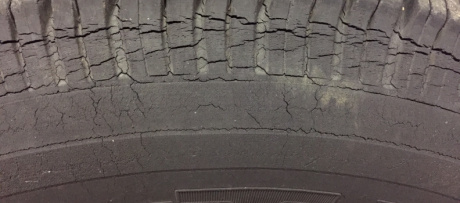
Tires are an integral part of a vehicle, and you should keep an eye on their condition. Refill them and replace them whenever required to maintain smooth and safe rides. Normally the need to replace a tire arises when it gets bald or wears down with time, but there are conditions when a tire becomes compromised prematurely because of different reasons. One such reason is Dry Rot.
In this article, we will be discussing what dry rot in tires is and how to prevent it.
What is Dry Rot?
Do not confuse the dry rotting of a tire with the dry rotting of wood often seen in houses. Dry rotting of wood happens due to organic growth and can spread from one object to another.
In contrast, a tire's dry rot is a type of decay which occurs due to the aging of the rubber or because the tire comes in contact with a destructive substance in routine. This type of decay does not spread to other tires.
A minor dry rot, if identified in time, can be repaired by using a sealing substance. But if you could not see the early signs, your tire will decay quickly, and there will not be any other option than changing the tire.
A rotten tire will not be able to hold the air inside. While driving, the rubber will stretch unnaturally, causing the tire to burst. Rotten tires are much more prone to blowouts, holes, and in extreme cases, the tread might separate completely from the tire.
What does Dry Rot look like?
Also known as sidewall cracking, as the name suggests, cracks start to appear in the tire. Following are the signs of Dry Rot.
- Tires become brittle due to dry rot. Rotting makes the tire dry by leaking the lubricants. Small patches of rubber start breaking from the tire.
- The tires' tread can also become covered with small cracks due to dry rotting. You will start facing problems in the handling of the vehicle.
- Cracks will become visible on the sidewall and might spread to a significant part of the tire.
- Fading of color is another sign of dry rot. Your tire will become a little grayish.
If you see any of these signs, then take your car to a professional for examination.
Causes of Dry Rot
Following are some of the reasons why dry rot occurs.
- Exposure to detrimental substances can cause dry rotting.
- Excessive sunlight can harm the tires.
- Freezing temperatures
- Scorching temperatures.
- Not using the car for longer periods.
- Underinflation.
How to Prevent Dry Rot
Dry rot can occur naturally due to aging, but you can take steps to slow it down. These tips can help you in preventing Dry Rot.
- Periodic maintenance can protect your tire from dry rotting.
- Reducing sunlight (UV) exposure can help you prevent dry rot.
- Clean your tires with non-petroleum products, such as water and soap.
- The tire should have proper inflation. It should neither be underinflated nor overinflated.
- Carry loads according to the tire capacity. Say no to overloading.
- Store your extra tires safely away from sunlight and other ozone-generating gear.
Same articles

Understanding Vehicle Inspection and Verification Services: Why They Matter for Every Driver
GuidesVehicle inspection and verification services are an essential but often overlooked part of keeping roads safe and cars legally compliant. Most people only think about inspections when it’s...
KLIFEX Brand Overview: High-Quality Automotive Repair Kits for Affordable Repairs
GuidesThe automotive aftermarket has long needed solutions that combine reliability, durability, and affordability. Many car enthusiasts and services are looking for a way...
Fast, Reliable Vehicle Emissions & Inspection Services Made Simple
GuidesFast, reliable emissions and inspection services are essential for keeping vehicles road-ready, compliant with environmental regulations, and safe for daily driving. If you’re looking for quick...

